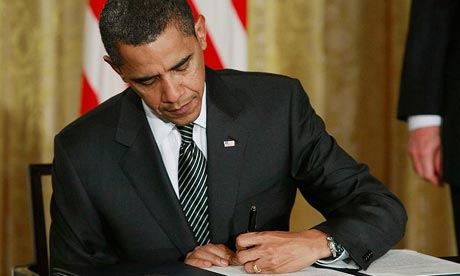by Jonathan S. Tobin • Commentary
 When conservatives protested President Obama’s attempt to go around the Constitution and rule by executive orders rather than with the consent of Congress, his defenders had a ready answer. While they insisted that Obama’s fiat granting amnesty to five million illegal immigrants did not exceed his authority, they also countered by saying that the president had actually issued far fewer such executive orders than that of President Bush. But, as USA Today noted last week, focusing only on executive orders while ignoring the far more numerous executive memoranda issued by this administration that have the same effect as law, the press and the public have vastly underestimated the extent of how far he has stretched the boundaries of executive power. If anything, this president’s effort to create a one-man government may have gone farther than we thought.
When conservatives protested President Obama’s attempt to go around the Constitution and rule by executive orders rather than with the consent of Congress, his defenders had a ready answer. While they insisted that Obama’s fiat granting amnesty to five million illegal immigrants did not exceed his authority, they also countered by saying that the president had actually issued far fewer such executive orders than that of President Bush. But, as USA Today noted last week, focusing only on executive orders while ignoring the far more numerous executive memoranda issued by this administration that have the same effect as law, the press and the public have vastly underestimated the extent of how far he has stretched the boundaries of executive power. If anything, this president’s effort to create a one-man government may have gone farther than we thought.
As of last week, Obama had issued 198 executive memoranda alongside 195 executive orders. That’s 33 percent more than Bush issued in his full eight years in office and 45 percent more than Bill Clinton. That blows a huge hole in the defense of Obama’s use of executive orders. Seen in this light, rather, as he and his media cheering section have contended, Obama has far exceeded the resort to unilateral measures of not only his immediate predecessor, but every one before that as well.
As USA Today explains, like the orders, memorandums have the force of law and don’t require the consent of Congress. Obama’s memoranda have run the gamut from the creation of new kinds of retirement savings plans, having the Labor Department require federal contractors to supply specific information to the government, forcing borrowers to cap student loan payments, three post-Sandy Hook shooting gun control measures as well as two memos that complimented his immigration amnesty orders.
That last point is crucial because the implementation of amnesty is largely being carried out by executive memorandums rather than orders. They also have the advantage of not being numbered in the Federal Register, as are executive orders. That makes it harder for Congress, the press and the public to keep track of them.
But lest you think it is a mistake to treat the memorandums as being as potent as the far more publicized orders, don’t rely on the authority of USA Today or Commentary. Ask one of President Obama’s appointees to the U.S. Supreme Court. In 1999, Justice Elena Kagan, who served as Associate White House Counsel in the Clinton White House, wrote in the Harvard Law Review that legal scholars made a mistake in focusing too much on executive orders while ignoring the memoranda.
Kagan said Clinton considered memoranda “a central part of his governing strategy,” using them to spur agencies to write regulations restricting tobacco advertising to children, allowing unemployment insurance for paid family leave and requiring agencies to collect racial profiling data.
“The memoranda became, ever increasingly over the course of eight years, Clinton’s primary means, self-consciously undertaken, both of setting an administrative agenda that reflected and advanced his policy and political preferences and of ensuring the execution of this program,” Kagan wrote.
When you consider how many more memoranda Obama has issued than Clinton, it makes Justice Kagan’s insight into how they can be used as a governing strategy even more important.
In practice, the memos are clearly executive orders by another name with no real difference. Even before Barack Obama had become president, they constituted a legal loophole that helped make an already increasingly imperial presidency even more powerful. But under Obama that problem has grown far worse.
The immigration overreach rightly scandalized many Americans not only because of the scope of the orders that were issued but because they represented an end run around the checks and balances that were put into the Constitution by the founders specially to avoid one man rule. One didn’t need to disagree with the president’s actions to understand that the process he was using represented a dangerous departure from the rule of law. But what few seem to understand is that the orders are only the tip of the imperial iceberg when it comes to President Obama’s effort to govern without having to wait for Congress to adopt the laws he wants them to pass. The outrage over the immigration orders is no tempest in a teapot. The president’s increased use of executive memoranda as well as orders ought to highlight a problem that might properly be termed a constitutional crisis rather than a mere partisan spat.
